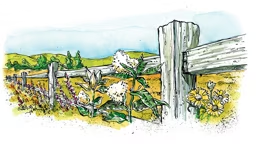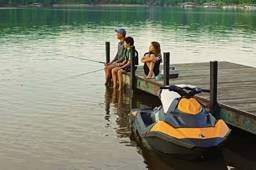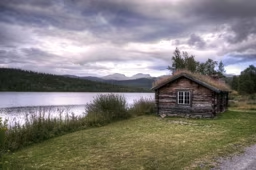Far away from that well-stocked garage, and many miles from a home repair store or professional help (or even the 20th-century, omniscient sage, Google), solutions to unexpected cabin problems can be tough to come by. But there’s no reason to let these little glitches ruin your leisure time – or your cabin budget. A little preparedness and how-to knowledge can get you through these problems with minimum investments in time or money.
Here are a few cabin-centric skills that will help you avoid or fix some of those unexpected problems at your home away from home.
1. Keep Your Deck Safe From “Rot Spots.”
While potted plants add character to the deck, they’re also repositories of moisture and dirt. Left in place over time, these pots can cause discoloration, mold and the eventual rotting of deck boards. Place potted plants on elevated stands or rotate positions each time you’re at the cabin to avoid these “rot spots,” which can spread like salmonella on sun-warmed chicken salad.
If you do find mold patches, use a commercial deck cleaner or a homemade cleaning solution (3 ounces of bleach per gallon of warm water) to clean and disinfect the area. You can double the bleach concentration for areas with heavy mold, but avoid heavier dosages whenever possible; the high pH of bleach can cause the wood fibers to break down, a process called lignification.
Grills can also cause discoloration and grease stains; attaching and maintaining a drip cup under the bottom of the grill chamber will reduce unsightly spots.
2. Smoke-Free Fireplaces.
Few things feel as good as a roaring wood fire on a cool day. The experience is even more enjoyable when you’re not hacking up wood smoke and wiping tears from your cheeks. But smoky fires are common – especially the first one of the weekend – and often drive everyone except chain-smoking Aunt Edna right back outside.
After making sure the chimney isn’t plugged, the best way to avoid a smoky start is to open up a window prior to starting the fire. This will equalize cabin pressure and allow the fireplace to exhale hot flue gases up the chimney. Gelled alcohol firestarters, available from most home improvement stores, produce a hot, nearly smokeless starter fire that will reverse the downward flow of cold flue gases on even those bitter winter evenings. To ensure the fireplace is drafting right, just tape a 6-inch strip of tissue paper at the near-edge of the top of the fire box opening; it will swing toward the back of the fireplace when air is properly moving up and out the chimney.
3. Safe Electrical Work.
Turning off the right breaker for simple electrical repairs is essential for staying safe during DIY electrical work. Easy enough, but neglecting this simple task – or turning off the wrong breaker – can cause quite a shock. Throw in renovations, faded or absent breaker labeling, plus old wiring schematics, and the odds that you’ll find the right breaker on the first try become downright Powerball-ish.
If you can’t shut down the entire power supply or you don’t have access to an electrical tester, just plug a stereo into the outlet in question. Crank up the music so you can hear it in the breaker room, then start flipping breakers. You know it’s time to go to work when the music dies.
4. Keep That Air Moving.
Ceiling fans aren’t just for those humid summer afternoons. Properly sized and installed, ceiling fans can improve the efficiency of your heating and cooling system. During summer months, set the ceiling fan so it’s rotating counter-clockwise (as you’re looking up at the blades). This will re-distribute cool air from the floor throughout the room. Come wintertime, flip the small electrical switch to reverse flow and push buoyant warm air down to floor level – your icy toes will thank you.
5. Plumbing Repairs.
Soldering clean, dry copper is so easy even I can do it with minimal fuss. Adding a new line or repairing a leaky fitting on an existing, closed system, however, is another matter entirely. The problem is simple, really: As you heat the pipes, residual water inside the copper tubing creates steam, which vents right out the juncture of the fitting you’re trying to close up.
The only way to get around this problem is to shut off the main water supply, drain all the pipes, and open up every faucet in the house. This will allow most of that steam (including the stuff coming out of your ears) to dissipate in other directions. Still having problems? Try jamming a piece of cheap white bread in the pipes as a temporary dam – the bread will soak up moisture during the soldering process, then dissolve and wash away once you turn the water back on.
6. Fix that Worn-Out Grill Burner.
$50 worth of steaks, a $500 stainless-steel grill, and your entire evening is derailed when a $20 burner won’t stay lit.
No need to panic. This is a common springtime problem for any grill. At the cabin, sporadic use means grease, salt and even insects can easily plug the venturi holes in the burners several times a year. A simple wire brush and a few minutes can get things cooking in short order. Simply turn off the gas, then remove the grating to get to the burner. Some burners will slide right out, while others are secured by clips or pins. Once you’ve got it free, use a wire brush to clean out the venturis. When you’re done, re-insert the burner and start charbroiling those steaks.
7. The Modern Campfire.
A smoldering campfire isn’t going to win you any points with the s’mores crew. Wet wood, windy weather and wimpy kindling all conspire against getting that fire going when you really need it.
Well, we’re not exactly cavemen anymore, so forget the birch bark and dry twigs and just add some hydrocarbons to the mix. Not gasoline – fun as it might sound, throwing gasoline on a campfire is a great way to lose a few fingers and blow out the windows on your cabin. Instead, consider keeping a bag of pre-soaked charcoal briquettes like Kingsford’s Match Light around. Kept sealed between uses, these briquettes will start in any weather and provide a great cooking base for typical campfire fare. You can add wood to the briquettes later for that authentic campfire experience.
8. Smother Stinging Insects.
Old wood buildings and lakefront property combine to create ideal habitats for wasps and hornets, and their peak activity often coincides with our August vacations. Dealing with these ornery critters is fairly straightforward – wait until dark, when the insects are least active, then spray the hive with a version of insect napalm that will shoot from a distance of up to 20 feet. Blanketing foams, like Ortho Hornet & Wasp Killer, will kill the entire nest. Just be sure to spray the hive’s entrance/ exit hole first … or pick a helper who runs slower than you do.
Kurt Anderson is a freelance writer who is an expert at hiding his DIY mistakes at the family cabin.







